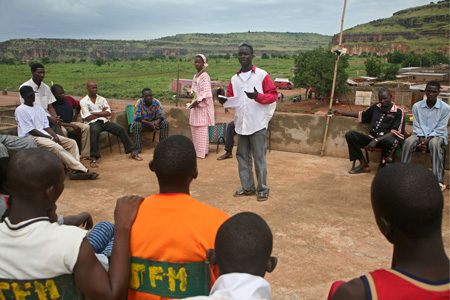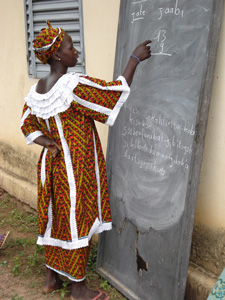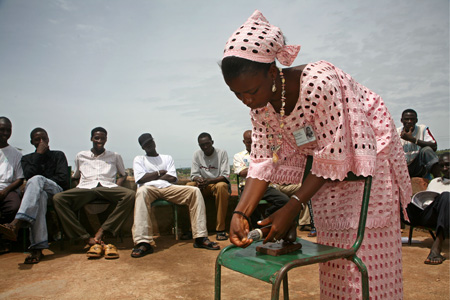Mali
Community Development Programme
Jeunesse et Développement
Country Profile
Population: 13 518 000 (2005)
Population below national poverty line: 63.8 % (1999 UNSD)
Adult Litercy Rate: 24 % (2003)
HIV-rate in adults (15-49): 1.9 (2003)
Context
Since 1993, Mali – one of the world’s poorest countries – has been undergoing a large-scale process of decentralisation aimed at bringing about cohesive and sustainable development. Local institutions have been established, but the efficient running of these institutions has been impeded by a number of constraints including:
- illiteracy and a general lack of education with regard to access, quality and management;
- local councillors’ lack of experience in managing public affairs;
- a lack of information and training for the various actors involved in implementing change;
- a growing lack of public spirit in rural areas stemming from the centralised running of the country; and
- poor health conditions and the worrying spread of the HIV/AIDS pandemic combined with the stigma and discrimination associated with the disease.
It is within this context that Jeunesse et Développement (J&D), a national NGO involved mainly in education, training and the provision of information, started its activities in the rural areas, with the objective of facilitating community self-development. Anxious to listen to its future partners and keen not to impose ready-made solutions on development issues, J&D carried out a month-long study in the region in 1999. The study focused on four areas (health, the environment, the situation of women and literacy) and its results were used as the basis for launching a programme in 2000. This programme concentrated on literacy and health and received initial funding from the British Embassy. Since then, it has been able to secure the assistance of other partners (Stromme Foundation, Mali Development Group, Methodist Relief and Development Fund and DVV International) to enable it to implement the other components of the programme.

Two instructors work with their group
Programme
The programme is aimed at women, men, schoolchildren, children out of school and local councillors in the communes of Sibirila, Yinindougou and Kouroulamini in Sikasso.
Its objectives are:
- To raise the public’s awareness of its rights and responsibilities, thereby increasing the rate of recovery of the Regional and Local Development Tax (TDRL) and to enable people to become involved in the implementation of the local, social and cultural development programme in each of the three communes;
- To scale up awareness-raising activities relating to civic education through the creation of Reflect literacy centres;
- To increase the proportion of the population with access to CS (child survival), RH (reproductive health) and STI/HIV/AIDS prevention services;
- To address and tackle child trafficking and exploitation by establishing an informal learning space for out-of-school children and early school leavers; and
- To improve the socio-economic conditions of women through a savings and credit scheme to mobilise local resources.
The programme’s conceptual model is founded on the values and principles of adult education, which encompass knowledge, expertise, interpersonal skills, participation and empowerment. It is operationalized through the STAR (Stepping Stones and Reflect) approach which is now widely used in many African communities. Reflect combines the tools and techniques of participatory research with communication techniques that follow the philosophy of Paulo Freire, while Stepping Stones is a communication and training tool, also based on participatory methods, which was developed to address the vulnerability of young people and women with regard to decisions about their sexual behaviour. This approach helps people think about a wide range of factors affecting sexual health such as gender relations, local traditions, attitudes to sexuality, money and alcohol. In both Reflect and Stepping Stones, the gender perspective is promoted.

A learner solves a sum on the blackboard
The methodology is based on the creation of Reflect/STAR circles in villages where the programme operates. These circles usually have around thirty members with key responsibilities and a clear desire to learn to read and write in order to be able to pursue their interests. These interests usually include health, education, the environment and citizenship. Led by a trained facilitator from the community, the circles meet several times a week (the participants themselves decide how often to meet).
The first part of each meeting involves discussions on and an analysis of a specific topic through the creation of a visual tool enabling everyone to participate. At this stage, HIV/AIDS prevention cuts across the topics discussed. The second part of the meeting is devoted to the elimination of illiteracy. The tool and contents of the analyses form the basis for learning – there is no need for alphabet primers or other written materials, thereby reducing the cost of resources compared with the traditional approach. Furthermore, the fact that learning is based on the ideas that arise from the discussions makes it a fairly rapid process. These groups act as nuclei at the heart of communities, generating ideas for action that will address the challenges analysed during meetings. Other community members, including traditional and administrative authorities, become involved when the ideas for action are implemented. This means that the population is responsible for planning and implementing development activities while J&D provides advice and support. There is a transfer of skills, not only with regard to the promotion of literacy but also in the organisation, project set-up and resource mobilisation. Broad-based participation that includes marginalised groups is a key principle embedded in this methodology.
The programme structure includes a programme coordinator and an assistant as deputy coordinator. Also included are three health workers, five community development workers, over 80 facilitators and a similar number of peer educators. The village committees are meant to oversee activities as well as provide concrete mechanisms for citizen participation. The Civic Education Committee builds citizen capacity through Reflect circles in villages, while the School Steering Committee looks after the transition of students from the non-formal to the formal education system. Meantime, the Women’s Group Steering Committee has a central office which is responsible for planning and implementing the group’s activities in savings and credit, market gardening, milling etc. Finally, the Children´s Committees are made up of parents who discuss ways and means of preventing child trafficking. Some village members are also identified as peer educators and are responsible for making reproductive health and STI/HIV/AIDS prevention services and items available to communities.
Facilitators (two per learning circle) are recruited from within the communities on a long-term basis, since they continue their activities even after the NGO funding runs out. In addition to facilitating, they also play a leadership role in local advocacy and in the implementation of programme activities. By way of initial training, facilitators receive 15 hours’ Reflect training, 8 days’ STAR training (reproductive health and HIV/AIDS) and 5 days’ training in project implementation techniques. Refresher courses in the topics identified during the monitoring assessments are held at least twice a year and there is also a quarterly forum for facilitators enabling them to share success stories, problems and potential solutions. Informal exchange visits that provide them with practical support are encouraged.
To ensure a literate environment that nourishes and supports initial literacy, a range of audio and visual materials is made readily available in the community library. One member of the civic education committee keeps a selection of related documents in his or her home. These contain information on decentralisation and tackle issues of democracy, and may be accessed by the villagers. In 2003, facilitators also launched a community newspaper, in response to a lack of specially-designed reading materials. A publishing committee composed of members of civic education committees has been set up.
The efforts to mobilise communities to improve their individual and community situation have yielded many results. At the community level, there are now civic action centres in every village. These contres consist of a library, a learning space for the acquisition of reading, writing and arithmetic skills, a legal activity space, and a video centre with audio and audiovisual cassettes. Alongside these civic action centres there are the community health centres (CHCs) with a high level of community participation, i.e a total of 3,075 members with 80% of membership cards owned by family heads. Aside from the village committees linked to Reflect that are mentioned above, village hygiene and sanitation committees have also been set up, indicating that community participation on a range of issues is vibrant. Eighty percent of the children who were formerly in the non-formal education system have been accepted and have moved to the formal system. Forty Reflect circles have been established with 1,080 members becoming literate every two years, 60% of whom are women.
Due to an increase in the proportion of people able to recognise and treat child illnesses (malnutrition, diarrhoea, acute respiratory infections, malaria) and STIs/HIV/AIDS, access to health care services and facilities has impoved. There are CHAs (Community Healthcare Associations) in place which a) involve the local population in coordinating and funding the establishment and running of CHCs; b) approach other partners to seek funding for the establishment and running of CHCs; and c) provide healthcare services (child survival, pre- and postnatal consultations, vaccination campaigns, preventive and primary care, STI/HIV/AIDS prevention and referrals) in the relevant regions.

Instructors demonstrate how to use a condom
Lessons Learned
It is clear that the involvement of communities in a programme’s implementation plays a key role in consolidating the knowledge that they have gained, even after the NGO is no longer involved, provided that a sustainable plan is in place that involves the state, communes and community leaders. The programme has also demonstrated that as people become increasingly well-informed about the laws and processes affecting their lives and environment, they start to take a more active role in decision-making and management processes. But this also means that there is a continuous need to build on the capacity of the population, authorities and local organisations so they can acquire more responsibilities and knowledge.
Remuneration for facilitators poses a big challenge. Usually it comes from each circle’s income-generating activities and is very low considering the increasing need for qualified individuals. Unfortunately, many organisations pay for managers and trainers yet refuse to give salaries to facilitators on the grounds that they are volunteers. This situation is weakening the programme, since the best facilitators opt leave and seek work in better-paid sectors.
The lack of a clear and well-defined framework for forming partnerships between state services and NGOs needs to be addressed because partnerships with clear lines of responsibility and contribution must be fostered to enable lessons to be shared and activities to be organised more coherently.
Contact:
Diarra Cheick Mahamadou
Coordinator
Jeunesse et Développement
Lafiabougou Rue 426
Porte 286
Bamako
Mali
diarra_sama@yahoo.fr
www.jeunesse-et-developpement.org

 Homepage
Homepage